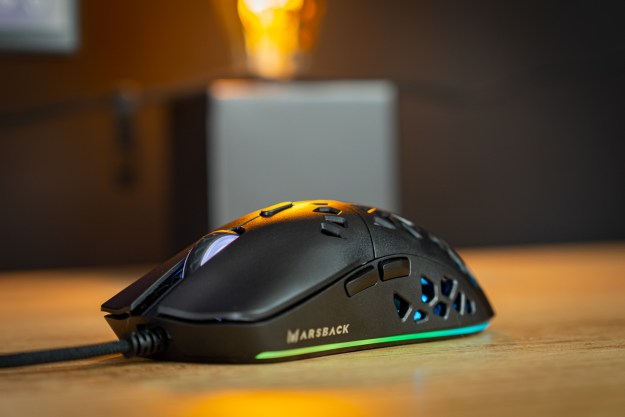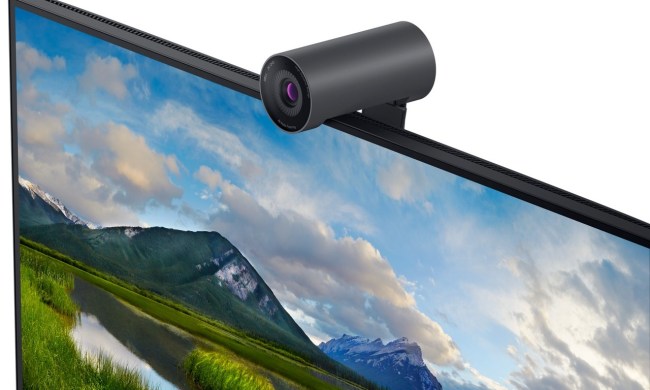
- Cooling fan does help
- Unique design
- Lathered in RGB
- Includes excellent sensor
- Great cable quality
- Not wireless
- Fan audible in quiet environments
- Ergonomically left wanting
There are dozens of great gaming mice out there. but many of them look and perform similarly.
That’s hardly the case for Marsback’s Zephyr Pro. This is a mouse that comes with a meshed body and a fan inside to cool the palm of your hand – and if that isn’t a feature that helps it stand out, I don’t know what is.
The fan is the Zephyr Pro’s calling card, but it also offers a light wired design with impressive gaming performance to boot.
Design and specs
Starting with the basics, the Zephyr Pro takes a simple wired mouse approach, with a false-ambidextrous design and large primary and navigation buttons only on the left side. The shell is made from plastic, and I’d say it’s about a medium-sized gaming mouse.
Thanks to the open mesh exterior, it also weighs in at just 69 grams without accounting for the very lightweight cable.
Underneath it all, the mouse is based on the Pixart 3389 sensor, which offers up to 16,000 DPI tracking that’s accurate up to 400 inches per second (IPS), which is impressive – the 3389 is among the best sensors, and it isn’t featured in many mice. This isn’t the most power-efficient sensor, but it doesn’t need to be as it’s a wired mouse.

Back to the cable for a moment. I have to jump in and say that it’s actually a highly impressive cable. Wireless mice are all the rage nowadays, but with a cable that’s this supple, yet thick, with a plush enough braiding not to be ugly, it’s difficult to be upset about not cutting the cord.
After all, the cable is something you’ll have to deal with if you want a fan in your mouse — that kind of power consumption isn’t sustainable on battery power alone.
Fans and cooling

Right underneath the palm area, you’ll spot the cooling fan, which believe it or not, has RGB lighting built into it. Unfortunately in this instance, I’m not someone twho generally sweats a lot, which makes testing this feature difficult.
So, I set out to do what any sensible hardware reviewer does: Put themselves in an uncomfortable situation for your reading pleasure. My office/gaming room is quite small — about 9 by 9 feet — and on a warm autumn day, I closed the door, the vents, set a second PC to run heat-generating programs, and fired up Insurgency Sandstorm on my main rig so that it, and I, could get to work.
My palms felt chilled, as if the mouse had a very light A/C built in.
After a few moments, it started to get warm. My cat had long left my lap, begged to leave the room, and I was getting uncomfortable. But without the luxury of being able to leave, and plenty of water in my system, the sweating started.
Lo and behold, the palm of my hand was the most comfortable part of me. It felt chilled – as if the mouse had a very light A/C built in, but it just seemed that way because it was the only part of my body that was getting any airflow.
Of course, most people won’t need to go to these lengths to test this feature. If under these conditions it helped me, then I’m sure it’ll help you, if you’re someone that’s prone to sweating, in much more normal circumstances. Heck, there’s a reason why companies like Cooler Master make the MM711.

I briefly switched to my all-time favorite mouse, the Logitech G Pro X Superlight, and the sweating became much more uncomfortable. For giggles, I also grabbed the MX Master 3, an office mouse with a very comfortable, but sweat-unfriendly finish, and the results were as sweaty as expected.
The fan is audible, but only if you hold your breath and try to hear it.
But is the Zephyr Pro quiet? After all, we’re building our PCs to be as quiet as possible, so it wouldn’t help if our mouse gets buzzy. On that front, I can report that the Zephyr Pro is adequately quiet. Place it next to a water-cooled PC that’s idling in a quiet room at night, and you’ll hear it. Quite well, in fact.
But in most normal, daytime circumstances, ambient noise will easily drown it out. And besides, you’ll likely be wearing a headset anyway. In the daytime, you have to hold the mouse up to your ear to hear the fan buzzing away.
Gaming performance

For testing the mouse’s actual gaming performance, I decided against doing this in the by-now hot and sweaty room. After I cooled it all off by opening a window, it was time for a few more rounds of Insurgency Sandstorm. As a realistic shooter, and with myself playing on a team against the maximum bot count, this is a great test – and the Zephyr Pro did a good job. It responded swiftly and accurately to my inputs, and easily kept up with my fast flicks thanks to the Pixart 3389 sensor. I play at a relatively low DPI of just 650, so yes, this mouse can track at high speeds very well — at least in this subjective test.
The only catch I had over my all-time favorite, the G Pro X Superlight, was that it isn’t wireless and had the cable dragging a bit – but in all fairness, that’s easily fixed with a cable bungee and time to get accustomed to the pointer. Otherwise, this mouse weighs and performs about the same, while having a cooling fan and RGB, and costing a lot less.
Our take
The Marsback Zephyr Pro approaches the mouse with holes approach slightly differently by including a palm-cooling fan and lathering the body in RGB. If you’re someone who is prone to sweaty palms during intense gaming sessions, and trypophobia isn’t something you’re troubled by, the Zephyr Pro is certainly a mouse to consider for your setup. It doesn’t have the most ergonomic shape, but as long as you’re not gaming for hours upon hours, it should provide great thermal comfort.
Are there any alternatives?
As far as mice with fans built-in, there aren’t many. However, there are plenty of alternatives that have “holey” designs, including the Glorious Model O, Cooler Master MM711, and the SteelSeries Aerox 3.
How long will it last?
With good care, the Marsback Zephyr Pro should last you about the years, mostly depending on the number of rage-quits you exert on it. The fan might also wear out if it’s used vert frequently, and cleaning the inside will be a challenge.
Should I buy it?
Yes, but only if you’re prone to sweaty palms to the point of losing grip on your mouse. Otherwise, there are better alternatives. But at the current price of $59, it’s hard to go wrong with this mouse, even if you just leave the fan switched off most of the time.





